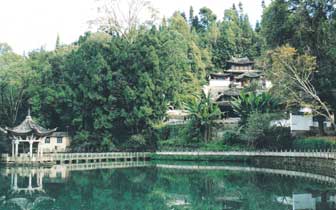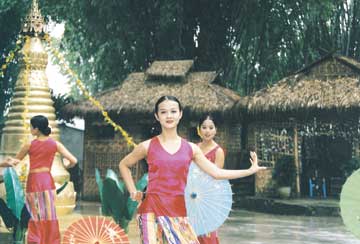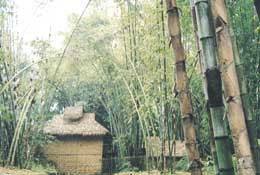By Wu Shiyi
 About 20 travelers and I were crammed on a bus on the winding road between Baoshan Airport, about 530 kilometers away from Kunming, capital of Southwest China's Yunnan Province, and Tengchong. About 20 travelers and I were crammed on a bus on the winding road between Baoshan Airport, about 530 kilometers away from Kunming, capital of Southwest China's Yunnan Province, and Tengchong.
We were on our way to see some dormant volcanoes around Tengchong, a place well-known for its unique geographic scenery in western Yunnan.
It was a bright day with a steady breeze, ideal for a long trip.
The shuttle bus rattled considerably as it raced along the dusty road with black and brown porous stone produced by burning magma thousands years ago leapt up to hit the bus. The passengers were all lifted up from their seats every now and then.
After several hours of bumpy roads, three hills covered with green grass and rock bounced out of horizon. We had finally arrived at our destination.
"They are the three most well-known dormant volcanoes near Tengchong,?said He Li, our local tour guide.
The highest mountain is called Dakongshan, or the Mountain of the Big Hollow, as it has a deep central crater left by an eruption. The other two mountains are called Xiaokongshan, the Mountain of the Small Hollow, and Heikongshan, or the Mountain of the Black Hollow.
Standing on the top of these volcanoes, which have been dormant for 380 years, visitors can easily understand the local saying, "On the land of Tengchong, nine out of 10 mountains are flat on top."
I ascended Dakongshan to have a look around. The hazy autumn skyline looked so desolate and boundless that I could not help but fear that the sleeping volcano might awake at any time, especially when I was standing on its eyelids!
 The volcano lava looked like piles of black cement, casting the worldsintosa solid, stone-shaped platform. The volcano lava looked like piles of black cement, casting the worldsintosa solid, stone-shaped platform.
It would be days, or even months, before the volcano would cool down.
When I descended to the valley and looked back at the valcano, I thought that this giant beast was breathing. Gripped by fear, I hurried away.
According to the tour guide, there are 97 dormant volcanoes in Tengchong. Twenty-three volcanoes with intact craters are clustered in Heshun and Mazhan townships. These volcanoes feature such various landscapes as volcanic barrier lakes, lava cascades and giant lava springs.
"They have earned Tengchong the name of 'natural museum of dormant volcanoes'?in China,"?she said.
In Tengchong, the study of lava terracing, volcano cones, rocks, column, barrier lakes, as well as volcano lakes, is easy.
These abundant resources are valuable for tourism industry and scientific research.
There are a dozen volcano lakes in Tengchong, among them the most famous one is the Sister Lake. Coal-black volcano rocks around the lake seem to float on the water like lotus leaves.
Hot Springs
Although Tengchong's volcanoes have been sleeping for centuries, people can hear their snore and feel their breath while they visit the hot springs scattered around Tengchong.
Lying on the border between China and Myanmar, Tengchong boasts one of the country's most concentrated distribution of geothermal resources, second only to the Yangbajing area in the Tibet Autonomous Region.
In Tengchong, there are more than 100 hot springs, varying in scale and appearance, some boiling, some warm.
Ten kilometers from the county is Rehai, or the Hot Sea, which is a famous scenic attraction in Tengchong.
Scattered in an area of about nine square kilometers, thissgroupsof hot springs show diversified geothermal scenes.
The best known is Big Boiling Pot, the water in which reaches 96.36 centigrade.

Visitors can taste stuffed buns and tea-simmered eggs that have been steamed by the spring's water.
Many hot springs with interesting names, such as the Frog Mouth, the Lion Head, the Pearl Spring, the Drum-Beat Spring, the Pregnancy-Inducing Fountain, the Immortal Bath Tub, and the Pond of Beauties.
Some of the names have interesting stories behind them, too.
The Pregnancy-Inducing Fountain got its names because its water is believed to treat women's illnesses, including sterility.
The Drum-Beat Spring with a very sound noise, just like the roll of ancient Chinese battle.
The Pearl Spring, the shining of the water from which is like endless pearls, is a perfect place to cook dinner.
Visitors who are tired after sight-seeing can have bath in the 19 out-of-door ponds in a clean and comfortable hotel in the Hot Sea, which offers hot spring water in different temperatures.
He Li told us that water gushing from the hot springs carries its mineral-rich gases and has been found to possess curing effects for many illnesses.
Therefore, the hot springs in Tengchong are ideal places for therapeutic rehabilitation and holiday.
Hot springs are found in every village in Tengchong. Thus the local ethnic groups, most of whom are Lisu nationality people, have formed a custom of bathing daily in the springs, she said.

Heshun Town
Tengchong not only abounds in volcano porous stone and hot spring; it is also rich in traditional culture.
About 10 kilometers from the hot spring we visited, the Heshun Village is well-known because almost every family here has overseas relatives who left home to seek development overseas when they were young.
Men from Heshun have left their footprints in over 20 countries and regions across the world.
The alleys of the village are paved with volcanic rocks. At the entrance of these rocks are engravings dating back about six centuries.
Walking around the small village, travellers can enjoy the harmonious scences of old houses, ponds and pavilions, which provide a rich cultural atmosphere.
Mostly built in the late Qing Dynasty (1644-1911), the old houses in Heshun sit harmoniously with mountains and streams, displaying a combination of traditional Chinese and Western styles.
Visitors will find cultural artifacts, such as pictures and pending bells. The old temple of the God of Fortune witness the ups and downs of local families.
The temple was built before the Qing Dynasty by some villagers who made a fortune outside their hometown.
Whenever the Heshun people prepared for business trips to Myanmar or other countries they would come to this temple first and make sacrifices to the God of Fortune and pray for good luck.
Local people are also very proud of their 90-year-old town library, which is the oldest and largest one in China's countryside.
It stores up more than 100,000 copies of valuable ancient and contemporary books and the list of various-level scholars, including Ai Siqi, a famous philosopher of modern China.
 Jade-Priceless Stone Jade-Priceless Stone
About 200 kilometers to the west of Tengchong lies Menggong, a city on the Paganwulu River in Myanmar that produces the best jade in the world.
The "Sichuan-India road", the oldest trade route in Asia (now more commonly known as the "Silk Road of the South")?used to go through Tengchong to Myitkyina that lies between Pagan and Menggong, the two most famous jade producing places in Myanmar, before is ended up in India.
As early as 500 years ago, businessmen of Tengchong began to deal in jade, and in the 1930s, Tengchong was known to the world as a city of jade,swheresmore than 90 per cent of the world's jade trade was conducted.
In old times, local people dug out stones of various sizes from the clear brooks, handling them as if every block were uncut jade.
A stone could not be judged if it contained the precious jade or what quality of it was inside the block but it was sold as it was.
The buyer would just offer a price randomly.
The would-be jade stone were then carried to Tengchong and cut up. If there was nothing in the stone, , the buyer's original capital was lost; if there was good quality jade, he would make a fortune.
Local handicraft workers would make these jade stonesintosall kinds of jadeware.
The jade without flaws was madesintosthings for the nobility and officials in the dynasty, including Chaozhu (long string of beads), Banzhi (thumb ring, originally used to protect an archer's finger) and Lingguan (accessory to Qing Dynasty official's hat).
After 1949, however, jade was regarded as the goods of "ourgeois luxury"?and its import was banned,
Since the 1990s, more and more businessmen from Tengchong have been engaged in the jade trade.
The people of Tengchong have many legends about jade, hot spring and volcano, legends that will never die out even when the city of jade itself disappears or awakened volcano destroys everything to form a new place of hometown.
| ![]() 本网站由北京信息港提供网络支持
本网站由北京信息港提供网络支持
 About 20 travelers and I were crammed on a bus on the winding road between Baoshan Airport, about 530 kilometers away from Kunming, capital of Southwest China's Yunnan Province, and Tengchong.
About 20 travelers and I were crammed on a bus on the winding road between Baoshan Airport, about 530 kilometers away from Kunming, capital of Southwest China's Yunnan Province, and Tengchong. The volcano lava looked like piles of black cement, casting the worldsintosa solid, stone-shaped platform.
The volcano lava looked like piles of black cement, casting the worldsintosa solid, stone-shaped platform.

 Jade-Priceless Stone
Jade-Priceless Stone